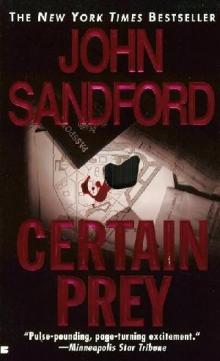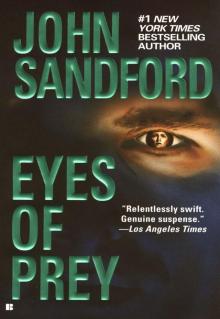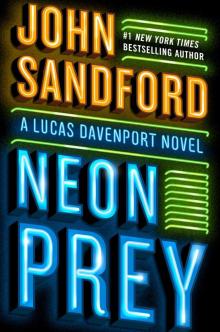- Home
- John Sandford
Uncaged
Uncaged Read online
ALSO BY JOHN SANDFORD
LUCAS DAVENPORT NOVELS
Rules of Prey
Shadow Prey
Eyes of Prey
Silent Prey
Winter Prey
Night Prey
Mind Prey
Sudden Prey
Secret Prey
Certain Prey
Easy Prey
Chosen Prey
Mortal Prey
Naked Prey
Hidden Prey
Broken Prey
Invisible Prey
Phantom Prey
Wicked Prey
Storm Prey
Buried Prey
Stolen Prey
Silken Prey
VIRGIL FLOWERS NOVELS
Dark of the Moon
Heat Lightning
Rough Country
Bad Blood
Shock Wave
Mad River
Storm Front
KIDD NOVELS
The Fool’s Run
The Empress File
The Devil’s Code
The Hanged Man’s Song
OTHER NOVELS
The Night Crew
Dead Watch
THIS IS A BORZOI BOOK PUBLISHED BY ALFRED A. KNOPF
This is a work of fiction. Names, characters, places, and incidents either are the product of the author’s imagination or are used fictitiously. Any resemblance to actual persons, living or dead, events, or locales is entirely coincidental.
Text copyright © 2014 by John Sandford and Michele Cook
Front cover photograph copyright © 2014 by Zmeel/Getty Images
All rights reserved. Published in the United States by Alfred A. Knopf, an imprint of Random House Children’s Books, a division of Random House LLC, a Penguin Random House Company, New York.
Knopf, Borzoi Books, and the colophon are registered trademarks of Random House LLC.
Visit us on the Web! randomhouse.com/teens
Educators and librarians, for a variety of teaching tools, visit us at RHTeachersLibrarians.com
Library of Congress Cataloging-in-Publication Data
Sandford, John.
Uncaged / John Sandford & Michele Cook. — First edition.
p. cm. — (The singular menace; book 1)
Summary: When an animal rights action at a research lab goes wrong, a terrible secret is exposed, and Shay must find her brother Odin before the researchers at Singular Corp. can silence both of them.
ISBN 978-0-385-75306-7 (trade) — ISBN 978-0-385-75307-4 (lib. bdg.) — ISBN 978-0-385-75308-1 (ebook)
[1. Adventure and adventurers—Fiction. 2. Animals—Treatment—Fiction. 3. Protest movements—Fiction. 4. Brothers and sisters—Fiction. 5. Science fiction.] I. Cook, Michele. II. Title.
PZ7.S21628Unc 2014
[Fic]—dc23
2013044491
Random House Children’s Books supports the First Amendment and celebrates the right to read.
v3.1
Contents
Cover
Other Books by This Author
Title Page
Copyright
Prologue
Chapter 1
Chapter 2
Chapter 3
Chapter 4
Chapter 5
Chapter 6
Chapter 7
Chapter 8
Chapter 9
Chapter 10
Chapter 11
Chapter 12
Chapter 13
Chapter 14
Chapter 15
Chapter 16
Chapter 17
Chapter 18
Chapter 19
Chapter 20
Chapter 21
Chapter 22
Chapter 23
Chapter 24
Chapter 25
Chapter 26
Chapter 27
Chapter 28
Chapter 29
Chapter 30
Chapter 31
Chapter 32
Chapter 33
Chapter 34
Chapter 35
Excerpt from Outrage
IN THE END …
The naked girl stared at herself in the motel mirror, a little sick with what she was about to do. She was slender, with muscles in her arms and shoulders, and red hair that fell to her waist. A scratch trailed from her hairline down to one eyebrow; her lower lip was swollen, raw on the inside where her teeth had cut into it. She had the salty taste of blood in her mouth.
She’d just gotten out of the shower, where she’d scrubbed someone else’s blood off her clothes and body.
Now for the hair. Has to be done, she thought.
She shook out the Walgreens bag. A pair of shears, a comb, and a box of Clairol Nice ’n Easy clattered down onto the Formica counter beside the sink. Behind her, the gray, wolflike dog was on its feet, watching her, picking up on the stress; the dog made a rumbling sound in its throat.
She turned and said, “You’re gonna get it too.”
The motel was a dump, built a half century earlier, twenty rooms stretched along a broken-blacktop parking lot. The room smelled of cigarette smoke, sweat, urine, whiskey, and disinfectant. The windows were glazed with dirt, and the venetian blinds were yellow with age. The bed was short and lumpy, covered with a shiny maroon bedspread that she didn’t want to touch.
Instead of throwing her clothes on the bed, she’d hung them on a hook by the shower. The wooden handle of a wicked knife stuck out of a sheath tucked inside the back pocket of the jeans.
An ancient television sat on a corner table. It didn’t work. The room had one solid appliance: the big chain on the door, which, she thought, it probably needed.
The motel office was down at the far end of the building. When she’d walked in a half hour earlier, the clerk, a too-thin, windburnt man in his forties with a hard, bobbing Adam’s apple, had said, “We don’t usually take dogs.”
She ignored the comment. “How much for the room?”
He looked her over. She wore a hoodie pulled down over her forehead, and sunglasses. The bottom part of her face was pretty, except for a bruised lip. Her only luggage was a man’s leather briefcase.
“Could be free, depending,” he said, trying to be cool about it.
He failed. The office looked like it hadn’t been cleaned since the place was built, with paper trash everywhere. A dusty box of Snickers candy bars was propped next to the cash register, the same cash register that had a trucker’s bumper sticker stuck to it that read ASS, GRASS OR CASH, NOBODY RIDES FREE. Somebody had crossed out the RIDES with a Magic Marker and written above it SLEEPS.
“I don’t want free,” the girl said. She dug a twenty-dollar bill out of her jeans, held it up with two fingers. “For me and the dog. I only want the room for a couple of hours, for a shower and a nap. I don’t need a receipt.”
He looked her over again, then reached under the counter and produced a key on a tag. “You’re in room eighteen. Be out by one o’clock. You bring in any guys, I get a cut.”
“Won’t be any guys,” she said. She snapped the bill down onto the counter, took the key, and was out of there.
Standing naked in front of the mirror, she picked up the shears and ran her fingers through her hair. No more sentimental moments; she started cutting. When she was done, long curls of red hair lay in the sink, like streaks of blood.
In the mirror, she’d changed: she looked lighter, thinner, almost elfin; the short hair emphasized her high cheekbones. She’d cut it just short of punk.
Now for the color. She took two bottles, a tube of conditioner, and some gloves out of the Clairol box, read the instructions, poured the color into the activator, and began working the black dye through her hair. Because her hair
was so short, she’d need less than half of it. Behind her, the dog whimpered.
“Smells like cat pee, huh?”
When she was finished, she picked up the comb, got the bottle, and said, “C’mere boy.”
The dog whimpered again.
An hour later, they were done. She pulled on her damp shirt, put the comb and shears in the briefcase, and used the last of the motel towels to dry her hair and the dog’s. He was contributing a whole new stink to the smelly room.
“Let’s get your collar back on,” she said. “You look undressed.”
The dog had been a silver gray. She’d used the comb to drag the color through the hair on his forehead, back, and sides, but hadn’t tried to get all of it. He looked pretty good in black and gray: like an off-brand German shepherd.
She looked off-brand herself. Different. So different that after she buckled the collar on the dog, she turned and examined herself in the mirror for a long minute, getting used to it.
Shay Remby was gone. Who was this new girl?
She moved the sheath and knife to the small of her back, pulled on her hoodie, and picked up the briefcase. The dog was already at the door. She clipped on his leash, tossed the room key on the table next to the TV, and then they were out of the motel and walking down the street, moving fast.
There had to be good parts of Stockton, California, she thought, but this wasn’t one of them. The streets were rough, the buildings decrepit. Broken windows were everywhere; the ones that weren’t broken were covered with bars or heavy mesh screens. A gang was busy tagging the bare concrete walls and every other flat place they could find.
She turned the corner and saw Spartan Assembly straight ahead. She had no idea what was done there. A factory of some kind, she thought, with fifty cars parked outside. The best place to hide a car, she’d learned in the last few days, is a crowded parking lot.
“You’re gonna smell up the Jeep,” she said to the dog. “I love you anyway.”
The dog rumbled at her.
The black Jeep Rubicon, almost new, sat in the middle row of the parking lot. She popped the door, let the dog jump into the driver’s seat, then pushed him over to the passenger side. A moment later, they were moving, the girl and the dog turning their heads to look out the windshield, the side and back windows.
On guard against the world.
Running.
1
IN THE BEGINNING …
The leader of the group had the Taser, a snub-nosed stun gun that looked like a miniature Super Soaker. There were six baseball bats and two commercial bolt cutters scattered among them, hung on loops beneath casual jackets. A seventeen-year-old boy, muscled up from white-water kayaking, had the ten-pound sledgehammer. They all carried ski masks and heavy work gloves.
Twelve young people altogether, male and female in equal numbers, most still in their teens. If they were stopped by the police, there would be no defense for the gear, so they were on edge, jumpy, looking around as they walked.
Ready to run.
But the distance from the cars was short, and the exposure was brief. A risk that had to be taken.
They had one big fence to get through.
The fence was twelve feet high, with razor wire on the top: they couldn’t climb it. The bottom of the fence was set in a band of concrete: they couldn’t dig under it. They couldn’t cut through it, or even touch it, because of a spiderweb of motion alarms.
There was one possible entry, at a back gate. The gate, which was almost never used, was secured with an electronic lock that opened only with the right magnetic card.
They didn’t have one of those. They did have a deck of obsolete cards, kept by the son of a former researcher. The boy was a computer hacker who’d studied the cards for years and claimed to have found the algorithm by which the codes were updated.
Eventually, one of the women in the group had paid attention to what he was saying. She’d led him through cyber attacks on several animal lab facilities, and the damage had been impressive. The woman took the high school senior as a lover to tie him more tightly to the group.
Two weeks earlier, he’d stuck a recorder card into the electronic lock to get a reading on the current lock code. A few hours later, he’d produced a new card that he swore would open the gate and silence the alarms around it.
Some of the members of the group had their doubts, but the boy didn’t. He was ultimately convincing.
All twelve of the raiders were committed, some more committed than others. At least two would give great sighs of relief if the card failed and they couldn’t get in.
The target was a research laboratory near the university in Eugene, Oregon, a heavy user of live animals: the usual mice and rats, but also rabbits, cats, and rhesus monkeys. The lab’s website was glossy and vague—a lot of PR double-talk about searching for a cure for Parkinson’s disease. But they had an insider who told them that something else was going on, something a lot stranger and meaner. The animals, he said, were being used and abused in ways that had no relevance to Parkinson’s or any other disease.
“They’re trying to make robots out of living beings” is the way he put it. “I don’t know why, but I think they’re planning to make robots out of people. They’ve killed hundreds of those monkeys, and they’re killing more all the time.”
The raiders were ready to believe. They’d all been involved in tree sitting, and tree spiking, and then more extreme environmental sabotage actions. They all knew each other and their various levels of commitment. Five of the twelve had been to jail at least once. The others had been luckier.
Or faster.
They crossed the parking lot in three groups, through the dense, fishy odor of the Willamette River, and converged on an alley between two anonymous warehouse buildings. The alley was the riskiest part, the part where it’d be almost impossible to run, where they could be trapped.
They saw no one.
Emerging from the alley, they moved sideways down the back of one of the buildings to three large Dumpsters that smelled of rotting vegetables and spoiled milk. The Dumpsters were fifty feet from the gate and provided temporary concealment.
The leader checked the power level on the Taser, then said, “Masks, everyone.”
The black knit ski masks came out of their jacket pockets. Sixteen-year-old Aubrey Calder giggled nervously as she fitted the breathing hole around her lip-glossed mouth and whispered, “I’m seriously wetting my pants.”
“You say that every time, but we’re six for six,” said Christopher, the sledge guy. “This is gonna work. This is gonna be awesome.”
The leader, the old man of the group at twenty-three, peeked around the Dumpster, scanned the orange sodium-vapor security lights, and said quietly, “I’m going for the gate.” Ethan led from the front, and it gave confidence to the others. He’d already done two years at Washington’s Coyote Ridge Corrections Center, where he’d learned to make pillows and mattresses. “My time in the joint,” he called it. It gave him a certain cred.
The target building seemed like a newer brick warehouse, an unfriendly one: small windows too high to see into and covered with wire-mesh screens. There were larger windows at the front of the building, but those looked into the lobby, and the lobby was secured from the rest of the building by locked reinforced steel doors. There were no signs identifying the building as a laboratory.
They would go in through a steel service door on the side of the building, for which they had a key provided by the insider. He couldn’t get them an electronic key card for the gate because he had no reason to have one, or to ask for one. He couldn’t ask for a service-door key, either, but he could be alone with a janitor’s key ring for long enough to press both sides of the key into layers of clay inside an Altoids tin.
Given perfect impressions, the raiders could make their own key. And they had.
The leader walked quickly, but didn’t run—running caught the eye—to the gate and slid the card through the reader
slot. Nothing. He cursed, ran it through again. Nothing.
In the alley, a girl named Megan whispered, “What the heck is he doing?”
“Quiet!” An order whispered like a fist in the face from the second-in-command, a woman named Rachel.
At the gate, the leader looked at the card, realized that he’d run the wrong side through, cursed again, turned the card, and pulled it down the slot.
The gate popped open and he said into his cell phone, “Yes.” He was a little surprised, and impressed, by the computer kid’s work. Definitely a major asset.
He pushed the gate open—seldom used, it was partly blocked by matted grass. He squeezed through, put his shoulder to it, and pushed it farther open, then walked across twenty feet of spongy, chemically enhanced lawn to the side of the building, to the gray steel door set into it.
The key worked perfectly, and he peeked inside: nothing but an empty stairwell. Their insider had said there were no motion alarms or surveillance cameras in this back hallway, though the lab was hardly naive about security. There were two dozen cameras spread throughout the complex, including two inside the animal containment areas. An armed security guard monitored the cameras overnight.
They’d asked the insider to recommend the lamest of the three night watchmen, and he’d fingered the pudgy older guy who was working on this night. Once the alarms went off—and they would—they’d have three or four minutes before the guard could get from his perch at the front desk, through several locked doors, to the second-floor containment area.
Time enough to do a lot of damage.
The leader put the cell phone to his face again, stepped over the threshold, and said, “Go!”
The raiders streamed across the tarmac, through the gate, across the grass, into the building. They knew exactly where they were going. They went down the hall, running, up the back stairs, through a fire door, and down another hall.
The steel door between the hall and the first animal containment unit was kept locked, but there were so many people coming and going that the lab workers left the key on a chain hanging on a coat peg inside the lunchroom. A security violation, but who’d ever know about it?

 Field of Prey
Field of Prey The Best American Mystery Stories 2017
The Best American Mystery Stories 2017 Mad River
Mad River Storm Front
Storm Front Night Prey
Night Prey Certain Prey
Certain Prey Heat Lightning
Heat Lightning Eyes of Prey
Eyes of Prey Golden Prey
Golden Prey Lucas Davenport Novels 6-10
Lucas Davenport Novels 6-10 The Night Crew
The Night Crew Broken Prey
Broken Prey Mortal Prey
Mortal Prey Dark of the Moon
Dark of the Moon Twisted Prey
Twisted Prey Stolen Prey
Stolen Prey Deadline
Deadline Secret Prey
Secret Prey Rules of Prey
Rules of Prey Extreme Prey
Extreme Prey Bad Blood
Bad Blood Gathering Prey
Gathering Prey Rough Country
Rough Country Sudden Prey
Sudden Prey Silken Prey
Silken Prey Buried Prey
Buried Prey Invisible Prey
Invisible Prey Silent Prey
Silent Prey Deep Freeze
Deep Freeze Bloody Genius
Bloody Genius Naked Prey
Naked Prey Winter Prey
Winter Prey Dead Watch
Dead Watch Escape Clause
Escape Clause Neon Prey
Neon Prey The Fool's Run
The Fool's Run Mind Prey
Mind Prey Easy Prey
Easy Prey The Devil's Code
The Devil's Code Chosen Prey
Chosen Prey The Lucas Davenport Collection, Books 11-15
The Lucas Davenport Collection, Books 11-15 Shock Wave
Shock Wave Shadow Prey
Shadow Prey Naked Prey ld-14
Naked Prey ld-14 Lucas Davenport Novels 16-20
Lucas Davenport Novels 16-20 Invisible prey ld-17
Invisible prey ld-17 Lucas Davenport Collection: Books 11-15
Lucas Davenport Collection: Books 11-15 Masked Prey
Masked Prey![[Prey 11] - Easy Prey Read online](http://i1.bookreadfree.com/i/03/22/prey_11_-_easy_prey_preview.jpg) [Prey 11] - Easy Prey
[Prey 11] - Easy Prey Silent Prey ld-4
Silent Prey ld-4 Storm prey ld-20
Storm prey ld-20 Eyes of Prey ld-3
Eyes of Prey ld-3 Certain prey ld-10
Certain prey ld-10 Lucas Davenport Collection
Lucas Davenport Collection Sudden prey ld-8
Sudden prey ld-8 Kidd and LuEllen: Novels 1-4
Kidd and LuEllen: Novels 1-4 Silken Prey ld-23
Silken Prey ld-23 Mad River vf-6
Mad River vf-6 Bad blood vf-4
Bad blood vf-4 Broken Prey ld-16
Broken Prey ld-16 Stolen Prey p-22
Stolen Prey p-22 Night Prey ld-6
Night Prey ld-6 Outrage
Outrage Mind prey ld-7
Mind prey ld-7 Shock Wave vf-5
Shock Wave vf-5 Easy Prey ld-11
Easy Prey ld-11 Prey 7 - Mind Prey
Prey 7 - Mind Prey Winter Prey ld-5
Winter Prey ld-5 Holy Ghost
Holy Ghost Uncaged
Uncaged Rampage
Rampage Hidden Prey ld-15
Hidden Prey ld-15 Buried Prey p-21
Buried Prey p-21 Secret Prey ld-9
Secret Prey ld-9 Chosen Prey ld-12
Chosen Prey ld-12 Phantom prey ld-18
Phantom prey ld-18 Mortal Prey ld-13
Mortal Prey ld-13 Saturn Run
Saturn Run Wicked Prey
Wicked Prey The Hanged Man’s Song
The Hanged Man’s Song Rough country vf-3
Rough country vf-3 Prey 25 - Gathering Prey
Prey 25 - Gathering Prey